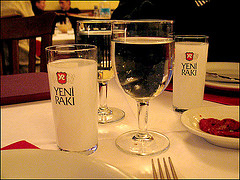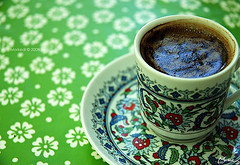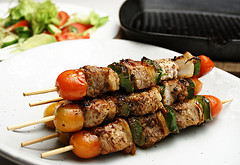TURKISH CUISINE
It is said that three major kinds of cuisine exist in the world; Turkish, Chinese, and French. Fully justifying its reputation, Turkish Cuisine is always a pleasant surprise for the visitors.
Turkish cuisine is largely the heritage of Ottoman cuisine, which can be described as a fusion and refinement of Central Asian, Middle Eastern and Balkan cuisines. Turkish cuisine has in turn influenced those and other neighbouring cuisines, including that of western Europe. The Ottomans fused various culinary traditions of their realm with influences from Middle Eastern cuisines, along with traditional Turkic elements from Central Asia (such as yogurt), creating a vast array of specialities- many with strong regional associations.
Taken as a whole, Turkish cuisine is not homogeneous. Aside from common Turkish specialities that can be found throughout the country, there are also many region-specific specialities. The Black Sea region's cuisine (northern Turkey) is based on corn and anchovies. The southeast—Urfa, Gaziantep and Adana—is famous for its kebabs, mezes and dough-based desserts such as baklava, kadayıf and künefe. Especially in the western parts of Turkey, where olive trees are grown abundantly, olive oil is the major type of oil used for cooking. The cuisines of the Aegean, Marmara and Mediterranean regions display basic characteristics of Mediterranean cuisine as they are rich in vegetables, herbs, and fish. Central Anatolia is famous for its pasta specialties, such as keşkek (kashkak), mantı (especially from Kayseri) and gözleme.
A specialty's name sometimes includes that of a city or region, either in or outside of Turkey, and may refer to the specific technique or ingredients used in that area. For example, the difference between Urfa kebab and Adana kebab is the use of garlic instead of onion and the larger amount of hot pepper that kebab contains.
TURKISH DESSERTS
One of the world-renowned desserts of Turkish cuisine is baklava. Baklava is made either with pistachio or walnut.
Lokum (Turkish delight), which was eaten for digestion after meals and called "rahat hulkum" in the Ottoman era, is another well-known sweet/candy with a range of varieties.
Kadaif ('Kadayıf') is a common Turkish dessert that employs shredded yufka. There are different types of kadaif: tel (wire) or Burma (wring) kadayıf, both of which can be prepared with either walnut or pistachio.
Among milk-based desserts, the most popular ones are muhallebi, sütlaç (rice pudding), keşkül, kazandibi (meaning the bottom of "kazan" because of its burnt surface), and tavuk göğsü (a sweet, gelatinous, milk pudding dessert quite similar to kazandibi, to which very thinly peeled chicken breast is added to give a chewy texture). A speciality from the Mediterranean region is haytalı, which consists of pieces of starch pudding and ice cream (or crushed ice) put in rose water sweetened with syrup.
Helva (halva): un helvası (flour helva is usually cooked after someone has died), irmik helvası (cooked with semolina and pine nuts), yaz helvası (made from walnut or almond), tahin helvası (crushed sesame seeds), kos helva, pişmaniye (floss halva).
Other popular desserts include; Revani (with semolina and starch), şekerpare, kalburabasma, dilber dudağı, vezir parmağı, hanım göbeği, kemalpaşa, tulumba, zerde, höşmerim, paluze, irmik tatlısı/peltesi, lokma.
Güllaç is a "Ramadan" dessert which consists of very thin large dough layers put in the milk and rose water, served with pomegranate seeds and walnut. The story tells that in the cuisines of the Palace, those extra thin dough layers were prepared with "prayers" as it was believed that if one did not pray while opening phyllo dough, it would never be possible to obtain such thin layers.
Aşure can be described as a sweet soup containing boiled beans, wheat and dried fruits. Sometimes cinnamon and rose water is added when being served. According to legend, it was first cooked on Noah's Ark and contained seven different ingredients in one dish. All the Anatolian peoples have cooked and are still cooking aşure especially during the month of Muharrem.
Kaymak (clotted cream-butter) is often served with desserts to cut the sweetness.
Tea or Turkish coffee, with or without sugar, is usually served after dinner or more rarely together with desserts.
Beverages
Alcoholic Beverages
Although the majority of Turks profess
the Islamic religion, alcoholic beverages are as widely available as
in Europe. However, some Turks abstain from drinking alcohol during
the holy month of Ramadan.
There are a variety of local wines produced by Turkish brands such
as Kavaklıdere, Doluca, Corvus, Kayra, Pamukkale and Diren which are
getting more popular with the change of climatic conditions that
affect the production of wine. A range of grape varieties are grown
in Turkey.
When one thinks of Turkey or Turks, one is reminded of Raki.
Although it is not known where or when this drink was invented, it
is certain that the history of raki does not go as far back as wine
or beer. It is a traditional alcoholic beverage flavoured with anise,
is the usual drink with meze, fish or kebabs. As a matter of fact,
the abolition of the monopoly of the state undertaking "TEKEL" on
the production of alcoholic beverages spurred the production of Raki
and wine in Turkey.
Non-Alcoholic Beverages
At breakfast and all day long Turkish people drink black tea.
Tea is made with two teapots in Turkey. Strong bitter tea made in
the upper pot is diluted by adding boiling water from the lower.
Wherever you go in Turkey, tea or coffee will be
offered as a sign of friendship and hospitality, anywhere and any
time, before or after any meal. Turkish tea is full-flavored and too
strong to be served in large cups thus it's always offered in little
tulip-shaped glasses which you have to hold by the rim to save your
fingertips from burning because it's served boiling hot. You can add
sugar in it but no milk, and you can have it either lighter (weaker)
or darker (stronger) depending on your taste.
Turkish coffee is a world-known coffee which can be served sweet or bitter. From the days of the Ottoman Empire through the present, coffee has played an important role in Turkish lifestyle and culture. In Turkish, there is a saying that emphasizes the importance in Turkish culture of offering a cup of coffee to someone: "a cup of coffee has a 40-year consideration". It should also be noted that although Arabs call their coffee Turkish coffee, it is different in aroma and taste from the classical Turkish coffee.
Ayran (salty yoghurt drink) is the most common cold beverage, which may accompany almost all dishes in Turkey. It is simply made by diluting yogurt with water. Some salt is added to taste. Best served chilled.
Şalgam suyu (mild or hot turnip juice) is another important non-alcoholic beverage which is usually combined with kebabs or served together with rakı.Şalgam is made from dark turnips and violet carrots and sira. . It has a dark red or purple color and a very strong soar taste.
Boza is a traditional winter drink, which is also known as millet wine (served cold with cinnamon and sometimes with leblebi).
Sahlep is another
favorite in winter (served hot with cinnamon). Sahlep is extracted
from the roots of wild orchids and may be used in Turkish ice cream
as well. This was a popular drink in western Europe before coffee
was brought from Africa and came to be known.



